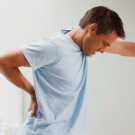
Ouch…I’ve hurt my back…
Getting the low down on what to do when you’ve hurt your back…
Well the first thing to say is ‘Don’t panic!’. Low back pain (LBP) is reported by 80% of people at some point during their life time, and the majority of it gets better within 6-8/52. In fact only 1-2% of people presenting with LBP will have a serious or systemic disorder and 90% is considered ‘non-specific’ (O’Sullivan and Lin, 2014).
What have I done?
Your back is one of the strongest structures in the body, made up of 24 individual bones, all with associated discs, joints and ligaments, and it is rare to do permanent damage to it. Often pain is associated with a sprain or strain of one of the structures in the back - similar to that which occurs in a ‘twisted ankle’, which can undoubtedly be very sore to move, but it will get better as you gently exercise it. It is also important to understand that back pain does not solely relate to tissue damage, but represents tissues being sensitised, which can occur secondary to awkward movements, poor posture, muscle tension, inactivity, lack of sleep, stress, worry and low mood (O’Sullivan and Lin, 2014).
Do I need a scan?
The current NICE guidance (2009) states that x-rays should not be offered for non specific LBP, and an MRI should only be offered in very specific circumstances. This is because there is a high prevalence of ‘abnormal findings’ on MRI in pain free populations, and the fear associated with receiving a diagnosis can make pain worse. A commonly reported diagnosis on an MRI is disc degeneration which people can find very worrying, however it should be noted that a study by McCullough et al. (2012) found that 91% of pain free individuals studied, also demonstrated these findings. At Cathedral Physiotherapy we are passionate about not letting you become ‘defined by your diagnosis’, and encouraging you back to full activity. The best way to rationalise the above findings is to think of them as normal changes associated with ageing, like getting grey hair!
Should I see a doctor?
The majority of LBP can be managed without seeing your GP. Follow the advice in the grey box and see a physiotherapist if things haven’t improved within the expected time frames, or if you are struggling to stay in work or return to your sport.
It is worth seeing your GP if you are needing more effective pain relief, but don’t forget to use your local pharmacist for advice first because this is quick and easy to do. Having said this, do see a doctor immediately if you are getting unremitting pain (especially not linked to activity or at night), changes in bladder or bowel control - especially leakage or being unable to pass urine, pins and needles or numbness in your saddle area between your legs, numbness/pins and needles or weakness in both legs, or unsteadiness on your feet. However, these symptoms are very rare.
If you have any further questions, or wish to have a session with our physiotherapist, please don’t hesitate to contact us at: enquiries@cathedralphysiotherapy.co.uk
References: O’Sullivan, P. and Lin, I (2014) PainManagementToday, Jan, 1, 1. McCullough BJ, Johnson GR, Brook MI, Jarvik JG. Lumbar MR imaging and reporting epidemiology: do epidemiologic data in reports affect clinical management? Radiology 2012; 262: 941-946.



